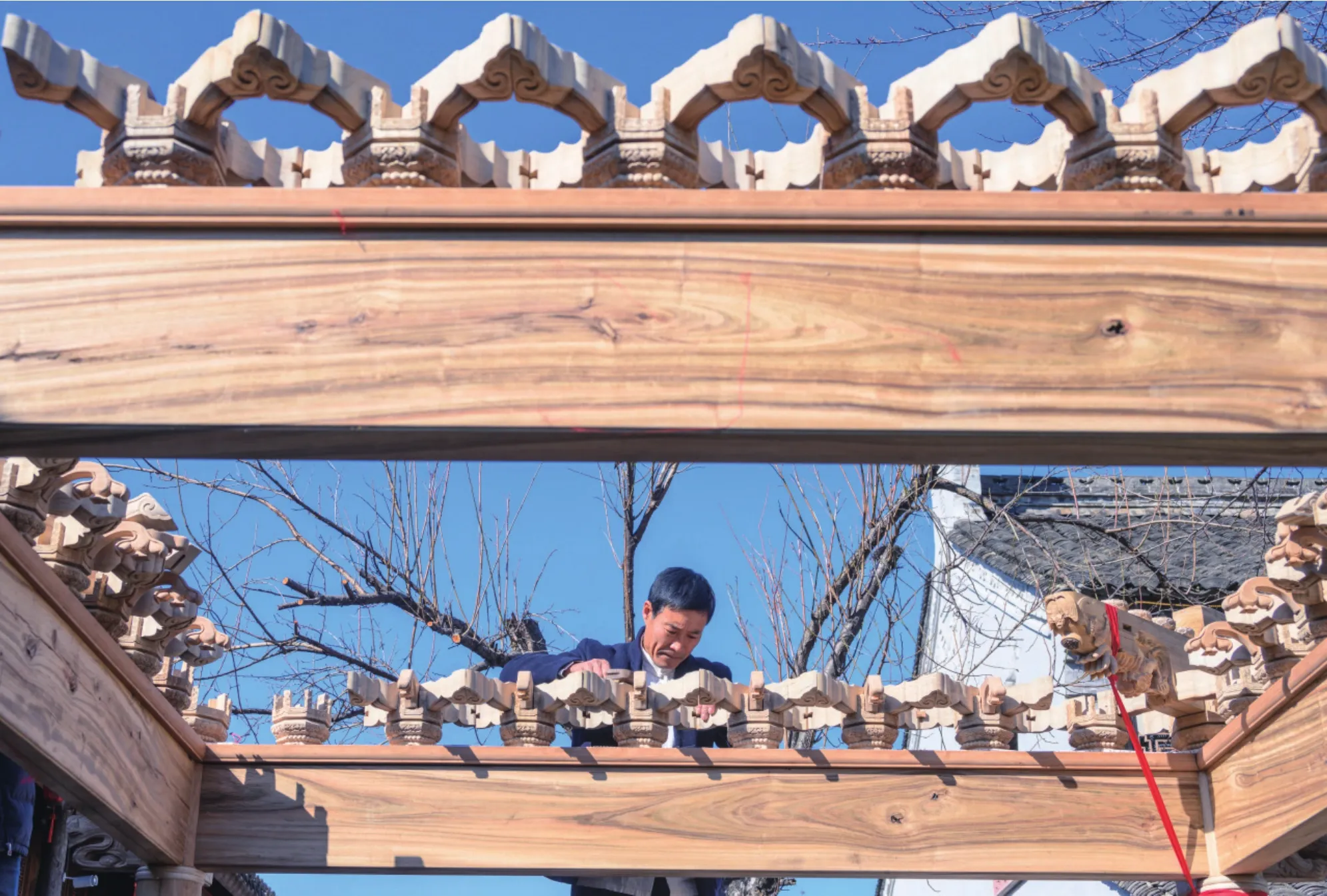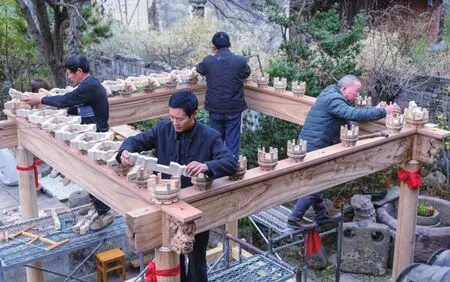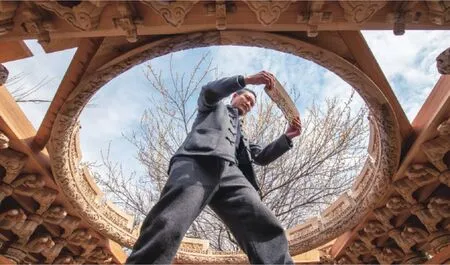5年“克隆”一座古戏台
2022-07-28郑梦莹
文/ 郑梦莹

葛招龙正在创作作品《人生·戏台》。Ge Zhaolong works on the carving work Life · Stage.
木结构的老宅子,门口青石板铺地。宁海县岔路镇湖头村的这处宅院中,有一座以宁海传统戏台建造技艺纯手工打造的精美戏台。
院子的主人、53岁的宁波市非物质文化遗产宁海传统戏台建造技艺代表性传承人葛招龙,正是凭借这座戏台,不久前从全国众多民间工艺美术作品中脱颖而出,摘得第十五届“中国民间文艺山花奖”。
葛招龙是名副其实的古建筑守护人。这些年来,他先后在宁海及周边县市主持修缮了20多座古戏台。葛招龙说:“好多年前,我就想在自家造个古戏台,这个愿望如今终于实现了。”戏台建造完工后,葛招龙为这件作品起了个名字—《人生 · 戏台》。
没用一颗钉子 以9000余个木构件组装完成
见到葛招龙时,他几乎是整个人趴在一块木料上,手眼并用,正为一块雕花板划出一个圆润的花骨朵。
木匠做雕花,眼睛就是把尺子,得目不转睛地盯着手头的木料,恰到好处的手劲也少不了。“这可是个细致活!”刻刀划到底,葛招龙的双手松了下来,转过头来对记者说。
《人生 · 戏台》正是在这样一刀一刀的精雕细琢中成型—这是一座飞檐翘角、雕梁画栋的木制仿古戏台,形制为四翘角歇山式,外形高6.6米,长、宽各5.3米,台面离地0.6米,大小是常见戏台的一半,可观赏,也可用于演出。
对于它,有的读者或许并不陌生。2021年8月,第五届浙江工艺美术双年展在浙江展览馆举办,222件作品上演了一场浙江民间艺术“宝藏秀”。《人生 · 戏台》就在其中。
《人生 · 戏台》是参评本届“山花奖”作品中体量最大的一件,要把它搬到参评现场,须用集装箱运载。“当时,我们10多个专业工匠花了五六天时间跟班拆卸、拼装。”葛招龙回忆道。
如今,这件庞然大物在外“游历”几番后,又回到了葛招龙的老宅中。站在戏台的台阶上,他向记者讲述着戏台背后的故事。
“看,这就是藻井,是整件作品中制作最难的部分。”顺着他的示意,记者抬头向上,看到戏台的螺旋藻井如花朵层层绽放。这自右向左盘旋而上的造型,由16层木质构件层层堆叠而成,一层一层盘成喇叭状。
令人惊叹的是,这件精美绝伦的作品由9000余个木构件组成,却没用一颗钉子。“这些都是用榫卯结构对接交叠出来的。”葛招龙说,“要严丝合缝,不然拼不起来”。
此外,戏台制作中使用了浮雕、圆雕、透雕等雕刻手法。“选料也很有讲究,使用了香樟木、乌楮木、老柏木等,都是有些年份的木材。”葛招龙说。
从小就很向往 戏台是“神圣的地方”
宁海被称为“中国古戏台文化之乡”。明清以来,在宁海建的庙宇、祠堂都有戏台。当地如今现存的古戏台有120余座,其中10座是国家重点文物保护单位。《人生 ·戏台》的原型,就是全国重点文物保护单位之一—宁海县城隍庙古戏台。
对这座古戏台,葛招龙再熟悉不过。2017年一年中,他就往这里跑了20多趟,就像小时候看戏那样端详着戏台,每次一待就要大半天。“别看这些木头块块似乎普通,这可是宁海戏台文化的灵魂。”
爱上戏台文化时,葛招龙还是个孩子。他常跟长辈去村里的古戏台看戏,在戏台前蹲着坐着、听着敲锣打鼓声就长大了,“对我来说,戏台是个神圣的地方,从小就很向往”。葛招龙说,他因此一直想在家中建一座仿古戏台。
理想很丰满,现实很“骨感”。仿造古戏台,费力费时又费钱,谈何容易!葛招龙曾在心里琢磨了许久。首先就面临一个很现实的问题,费用太多。这些年,他虽然攒了点钱,但还不足以承担这笔费用。“你干什么,钱多了?”最开始,妻子就提出了质疑。
不过,随着心中的念想越来越强烈,葛招龙最终还是没忍住与志同道合的朋友念叨念叨,“赔钱也想干”。想不到葛招龙一说,朋友们纷纷响应。箭在弦上不得不发,他带着几个工匠,一咬牙就干了起来。
从采风到设计,从构件制作到整体搭建,再到改进、完善,这个纯手工打造的“古戏台”前前后后花费近4000个工时。“图纸就画了一年,找寻合适的雕刻构件用了两年多时间。这些都准备好后,我们就在这个院子中开工搭台。搭了拆、拆了搭,反反复复,足足又花费一年才完工。前前后后,总共用了5年时间。”葛招龙掐指算道。
“画一张图纸就要这么久?”面对记者的疑惑,葛招龙耐心地解答起来:修复古戏台时,可以一层一层地把构件拆下来,把损坏的部分挑出来进行修补或替换,再按原样一个一个拼装回去。但“克隆”一座比例缩小一半的古戏台,还要融宁海古戏台之长,没有现成的资料可参考,相当于从“白纸一张”开始画。

《人生·戏台》。Life · Stage.

《人生·戏台》局部。Life · Stage (partial).

葛招龙与工友正在创作作品《人生·戏台》。Ge Zhaolong and his colleagues work on the carving work Life · Stage.

为此,葛招龙只能一趟一趟跑,一来到古戏台前,就坐下来细细琢磨祖辈口口相传的技艺口诀,并结合多年修复古戏台的实践经验,在薄木板上按比例描摹、切割出戏台的每一个部件。打样后,才能一个一个拼接起来看效果,不行就推倒重来,一改再改。
修复古建筑 10多年来需求渐旺
“最近还有项目正在做吗?”记者问。“项目怎么能没有呢,一直有的。”葛招龙说。
葛招龙的确很忙,结束《人生 · 戏台》这个大工程后,他一直没停歇,最近又开始忙于修复敦义堂,有时候甚至来不及看手机回复消息。敦义堂位于宁海县西店镇岭口村,是典型的清代早期浙东地区宗祠建筑,占地面积约1200多平方米,其部分木质建筑构件已存在不同程度的变质、糟朽。
葛招龙18岁拜师学艺,曾靠着一手精湛的木作技艺走南闯北。后来行业式微,他一度放下手中的工具箱,做起了小生意。不过,兜兜转转,这门手艺在乡村振兴的大背景下又有了用武之地。
2011年,葛招龙发现古建筑修复需求越来越多,于是喊上四里八乡的能工巧匠,组建了一支古建筑修复队,开始承接各种各样的古建筑修复项目。从2014年起至今,他们已经修复古建筑160余处。
对于老物件,葛招龙有着天然的情结。在别人眼里一条普普通通甚至是破败的老街,在他看来却样样是宝,一个屋檐、一块木雕、一片瓦当,他都要用手机拍下来。在他的手机相册中,古建筑修复工地和这些老物件的图片最多。
“大家对古建筑的保护越来越重视了。这些老祖宗的‘遗产’,让我心存敬畏,我一定要守护好。”葛招龙说。
How to “Clone” an Ancient Opera Stage?
By Zheng Mengying
A wooden structured old house, with dark flagstones paved in front of the gate. Inside it, located at Hutou village, Chalu township, Ninghai county of Ningbo city, there lies an exquisite opera stage hand-carved using the traditional Ninghai opera stage building craft.
The owner of the house, 53-year-old Ge Zhaolong, is a representative inheritor of the crafting technique of ancient opera stages, which has been listed as Ningbo’s intangible cultural heritage. It is thanks to opera stage that Ge recently won the 15th Shanhua Award, the highest folk-art honor in China.
Ge is a veritable keeper of ancient buildings. Over the years,he has been in charge of repairing more than 20 ancient opera stages in Ninghai and in the surrounding counties and cities. “I have long wanted to build an ancient stage in our house, and my wish has finally come true,” said Ge. For the award-winning work,Ge named it “Life · Stage”.
Right now, Ge is finishing another piece of work, with him almost lying on his stomach on a piece of wood carving out a round flower bud for a carved board. For a woodcarver like Ge, his eyes are like the ruler, as he must have them constantly fixated on the wood pieces at hand.
“It is a most delicate job!” Ge chuckled.
has been created through such meticulous carving.It is a richly ornamented wooden antique stage with flying rafters.Adopting aor hip-and-gable roof style, the stage measures 6.6 meters in height and 5.3 meters in length and width. With a stage height of 0.6 meters, it is about half the size of a regular stage, and can be both a work of art to be admired and an actual stage to be used.
As the biggest piece of work to compete for the Shanhua Award in 2022,needed to be put into a container before it was moved to the place where all the entries were evaluated and judged. “At that time, more than 10 professional craftsmen spent five to six days disassembling and assembling the stage,” Ge recalled.
Now standing on the steps of the stage inside his house, Ge began to tell the story behind it.
“Look, this is the caisson, the most intricate part of the whole piece,” said Ge. Spiraling from right to left, 16 layers of wooden components stack on top of each other, each layer coiled in the shape of a trumpet.
What is most amazing is that not a single nail or screw is used for the stage, which is made up of more than 9,000 wooden pieces.“They have been connected via the traditional mortise and tenon structure,” said Ge. “Therefore, each piece needs to be carefully calibrated, or else they wouldn’t fit together.”
In addition, different carving techniques such as relief, round carving, pierced carving. “Some of the best raw materials have been selected, including camphor wood, mulberry wood and cedarwood,” according to Ge.
Known as the hometown of Chinese ancient opera stage culture, Ninghai county is home to over 120 ancient opera stages,10 of which are listed as national key cultural relic protection units and have been around since the Ming dynasty (1368-1644). The inspiration foris the Chenghuang (City God) Temple operat stage in the county.
Ge couldn’t be more familiar with the stage. In 2017, he made more than 20 trips, spending half a day every time examining the stage as he did during childhood. “Although these pieces of wood seem ordinary, they are the soul of Ninghai’s opera stage culture.”
Ge fell in love with the stage culture when he was a small child. He often went to the ancient stage of his village to watch opera performances with his elders. He grew up squatting and sitting in front of the stage, listening to the beating of gongs and drums. “For me, the stage is a sacred place,” Ge said. Indeed, he had long hoped to build an antique stage in his home.
But the realities can be harsh. To build an ancient stage is no easy task at all, which is laborious, time-consuming and costly. Ge had thought about it for a long time. To begin with, where could he find all the money? Although he had some savings over the years, they were far from enough to cover the costs. “What are you doing? Have too much money to burn?” Ge’s wife raised doubts even before he started out.

图为葛招龙正在创作作品《人生·戏台》。Ge Zhaolong works on the carving work Life · Stage.
However, as the desire grew stronger in his mind, eventually Ge couldn’t resist telling like-minded friends that he would like to work on it even if he lost money. Unexpectedly, his friends responded readily to his call.These craftsmen set to work at once with him.
From field trips to design,then from component production to overall construction, and to further improvement and perfection, nearly 4,000 hours have been spent on this handmade ancient stage. “The drawings took a year and the carving more than two years,” Ge said. “When all were ready, we set to work in the courtyard, building before tearing everything down, over and over again, which took another year.”
When restoring an ancient stage, the components can be removed layer by layer, the damaged parts can be picked out for repair or replacement, and then put back together one by one.However, to “clone” an ancient stage with half the size is no simple matter, as there is no readily available information for reference,which is equivalent to starting from scratch.
Hence Ge’s multiple trips to the Chenghuang Temple ancient stage. Every time when he came to it, he would sit down,carefully remunerating the craft handed down to him orally over the generations through pithy formulas. Combining his years of practical experience in repairing ancient stages, he would paint and cut out each part of the stage in proportion on a thin wooden board. Each component would then be made and connected. If it didn’t work, Ge would have to redraw, recalibrate and remake each part, time and again.
Lately Ge is quite busy. He has been working on the restoration of an ancestral hall in a nearby village after completing—sometimes he doesn’t even have time to check his phone to reply to messages.
In 2011, Ge found that there was a growing demand for the restoration of ancient buildings, so he called on skilled craftsmen in neighboring towns and villages, organized them into a team specializing in restoring ancient architecture and began to undertake various projects. Since 2014, they have restored more than 160 ancient buildings.
Ge has a natural affection for old objects.An ordinary or even dilapidated old street would be treasures in his eyes. He would take photos of eaves, pieces of wood carving and tiles. In his cellphone photo album are all those restoration sites and “old” objects.
“People are paying more and more attention to the protection of ancient buildings,” Ge said. “I’m simply awed by these heritages passed down from our ancestors, and I will everything I can to protect them.”
